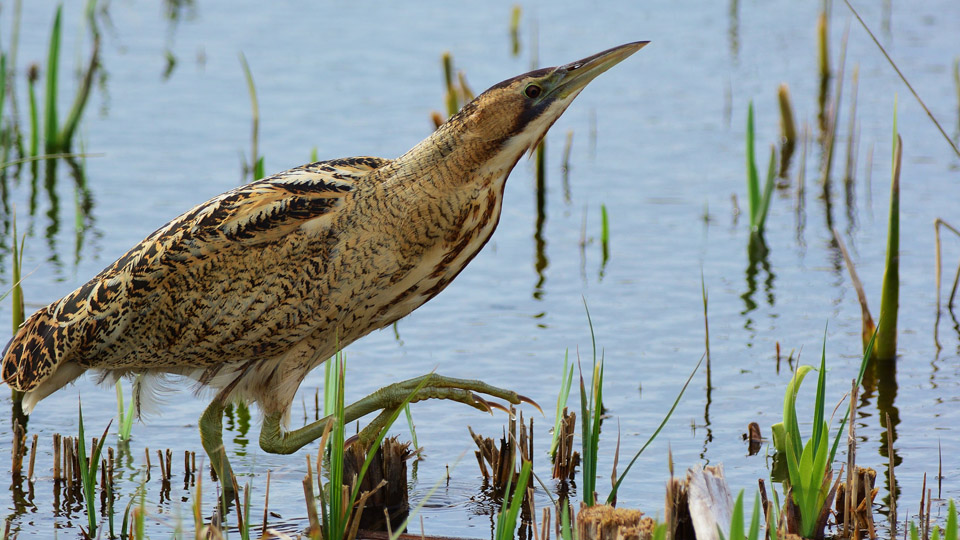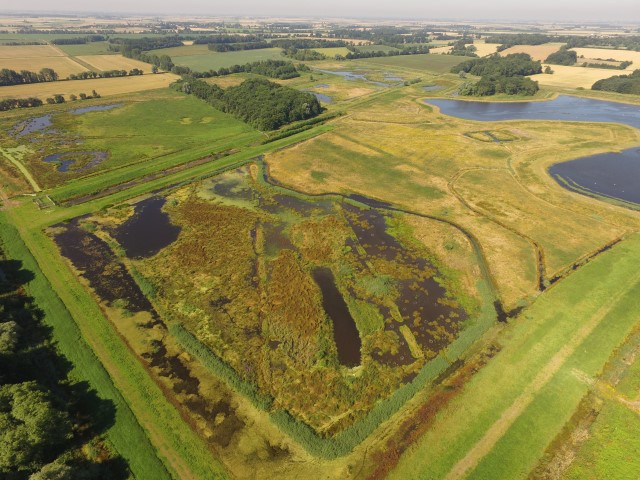There was a time when the bittern was commonplace in the landscape of East Anglia; so commonplace indeed that in the Wife of Bath’s Tale, written in the 1380s, Chaucer used the crouching bird to suggest the posture of the queen whispering her secret to the reeds. If the same image were used today, few would understand it. The bittern has disappeared from the national psyche because, along with our wetlands, it has all but disappeared from our landscape since the time of Geoffrey Chaucer.

Bittern, photo by Elizabeth Dack
By the early 1900s bitterns were perilously rare in Norfolk, and indeed the UK, with almost all birds concentrated around Hickling. In 1937 the new Warden, Billy Bishop, found the first bittern nest at Cley Marshes and immediately phoned his employer Dr Sydney Long. Billy recalls in Cley Marsh and its Birds: ‘He asked if I was sure of my facts. Could it perhaps be a pheasant’s nest? I replied that it was a bittern that rose from the nest, well understanding his doubt, as the eggs of a bittern are very similar to a pheasant’s in colour and size.’ Billy was right and bitterns went on to breed at Cley for many years, with as many as five males booming in the 1950s.
It was not until 1989 that marsh harriers returned to breed in what is now termed the Cley to Salthouse Living Landscape. Today a handful of these graceful birds make their home in the reedbeds of this beautiful stretch of the North Norfolk coast. Bearded tits, reed, sedge and Cetti’s warblers, reed buntings and water rails complete the reed-specialist avifauna of Norfolk Wildlife Trust’s Cley and Salthouse reserves.
Good habitat for all of these species essentially depends on freshwater. Cley and Salthouse are not naturally freshwater marshes. They were embanked in the seventeenth century to keep out the tides, thereby creating better grazing for livestock. The artificial banks have been maintained ever since, with the shingle ridge which runs across the north of the reserves bulldozed into tide-resisting shape each winter. However, over time, the Environment Agency concluded that this management was neither sustainable nor effective in the longer term and in 2007 ceased managing the ridge in this way such that it is returning to its natural profile. As a result, in time it is likely that the marshes will again become increasingly a mosaic of brackish and saltmarsh habitats.
Saltmarsh is splendid habitat for sea aster, for sea purslane, for wintering curlews and brent geese, for merlins and for redshank; but it is no good for nesting if you are a rare bittern, bearded tit or marsh harrier. Under the European Commission Habitats Directive the Environment Agency was therefore obliged to create freshwater habitats elsewhere, for bitterns and other specialists, to compensate for their eventual loss at Salthouse and Cley.
As luck would have it the late Steve Henson, then a conservation officer at Norfolk Wildlife Trust, knew of a farmer in the Wissey Valley at Hilgay who had some land too wet for him to cultivate which he hoped to see turned into a wetland for wildlife. Initially it was questioned whether the site, so far inland, could meaningfully replace the marshes at Cley and Salthouse. However, with most of East Anglia’s low-lying coastal wetlands under similar threat from rising sea levels, the Environment Agency approved these soggy fields at Hilgay as the site for a new compensatory wetland. Norfolk Wildlife Trust tendered a proposal for the project and won. A remarkable new wetland had been conceived and from autumn 2008 it began to be engineered.
Saltmarsh is splendid habitat for sea aster, for sea purslane, for wintering curlews and brent geese, for merlins and for redshank; but it is no good for nesting if you are a rare bittern, bearded tit or marsh harrier
Of all the terrestrial habitats in the UK, freshwater wetlands are the easiest to create, or in the case of this patch of drained fenland, to recreate. In one sense it is a case of just adding water and allowing wetland wildlife to return. Managing the water safely, efficiently and cost-effectively is a different matter. The reed which today is beginning to colonise the new wetland at Hilgay, forming future habitat for bitterns and bearded tits, is the result of years of planning, engineering, fundraising and hard graft.
Water comes onto the reserve from the River Wissey, and is held in a huge, horseshoe-shaped reservoir, which itself is both a feat of engineering and an attraction to birds. NWT’s engineers drew up careful plans and underwent a painstaking series of inspections to obtain a certificate to build the dam, which, if flawed, could damage or endanger local people, livestock and their livelihoods, but without which the whole project would have been impossible. The reservoir was built at the north end of the new reserve, where soils were least acidic and therefore least likely to contaminate the water it held. From the reservoir water is paid out into carefully sculpted wetlands through a series of sluices.
Only once heavy machinery had done its landscaping could gardening for wildlife begin. Given the right conditions reed colonises new wetlands superbly. Drawing on the experience of similar projects elsewhere, reed has been planted at Hilgay by burying rhizomes (the plants’ underground stems with which they propagate themselves), planting pre-grown plugs (some 50,000 so far) and by simply poking living shoots into the mud. To protect it from the many greylag and Canada geese which have found the reserve to their liking, most of the reed has been planted within enclosures of poultry wire, which will be removed once reedbeds have formed and are self-sustaining. Research has shown that demanding bitterns need not just reed but also fringes where reed meets open water, so care has been taken to leave open channels of deeper water, just to the fussy birds’ liking.

Hilgay, photo by Hexcam
While reed has only just begun to colonise and will take time to form dense reedbeds suitable for rare birds, the reserve’s open water has been quick to prove popular with wildlife. From the project’s inception staff and volunteers at Norfolk Wildlife Trust have carried out both Wetland Birds and Breeding Bird Surveys, under national schemes coordinated by the British Trust for Ornithology. As a result we have a fine picture of the birds which use the reserve. Avocets quickly moved in and bred, and little ringed plovers came too, both species loving the open islands of young wetlands. The beautiful garganey, a migrant duck from Africa, is suspected to have bred among the young reed and a colony of black-headed gulls has formed. Winter flocks include wigeon, teal, gadwall, shelduck and great crested grebe, with some of these staying to breed. As the reed grows, reed and sedge warblers are moving in too.
The Hilgay reserve has so much promise that next door Natural England and the Environment Agency have supported the purchase and rewilding of a second NWT site, known as the Methwold reserve, bringing these two restored wetlands to a total of 130 hectares. Heavy machinery has again been used to carve scrapes and pools and now, as at Hilgay, the process has begun of planting reed, managing water levels and watching as wildlife returns.
The Hilgay and Methwold reserves make fitting tributes to Steve Henson who was passionately committed to conservation. The work he began, of restoring wetlands in the Wissey Valley, continues today in the hands of staff and volunteers at Norfolk Wildlife Trust, volunteer birdwatchers and reed-planters, neighbouring landowners and many colleagues in other conservation agencies.
Marsh harriers are already seen daily over the spreading reedbeds at Hilgay and Methwold. Soon, it is hoped, they will nest. Signs of otters and water voles can be found across the reserves. In five years, perhaps, spring evenings will resonate with the deep booming voices of bitterns: a sound well known to Chaucer and his contemporaries, a sound which belongs in the wetlands of East Anglia, and which, with a little human vision and plenty of hard work, may be coming back to them.
Norfolk Wildlife Trust is committed to opening its nature reserves across the county to the public, for their enjoyment and education, and above all the watching of wildlife. Reserves are only not opened when access would be difficult, dangerous, or harmful to rare wildlife. This is particularly important when new habitats and populations are establishing as is the case on these new wetland sites. For the foreseeable future the Hilgay and Methwold reserves will remain closed to the public. However parts of them are viewable from the bank of the River Wissey and can be enjoyed in this way.